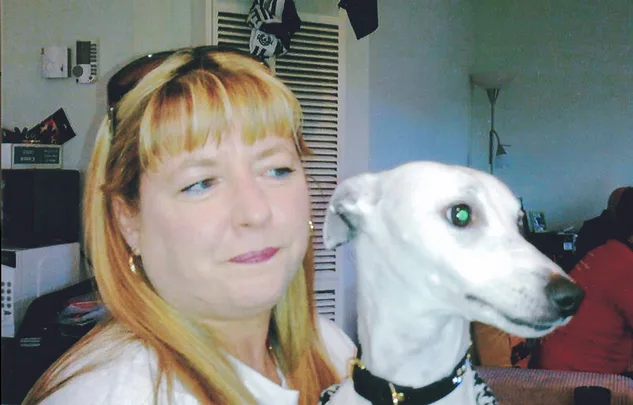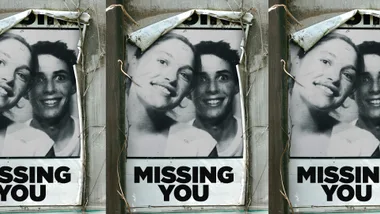The family of a woman who was murdered by her ex-husband is suing the police after she called them for help 38 times in the week before her death.
Kelly Thompson, 43, was stabbed to death by Wayne Wood in her home, south-west of Melbourne in February 2014.
Shortly afterwards, marie claire ran a story detailing the horrific sequence of events that lead to Thompson’s murder.
In marie claire’s story, her mother, Wendy, recounted the moment she discovered her daughter was dead. She and husband John questioned why the system let their daughter down – and why she wasn’t protected by the intervention order she took out against Wood.
This week their lawyer Paula Shelton told The Herald Sun that “Given the findings of the Coroner that there were numerous deficiencies in the management of Kelly’s safety, I think there’s cause for the family to seek compensation.”
Read marie claire’s story from 2014, by Fenella Souter, below.
On a scorching Tuesday afternoon in February this year, John and Wendy Thompson received a garbled phone call from their son. It was the type of call every parent dreads. The kind that leaves you faint. The kind that blocks out every noise except your own pounding heartbeat.
The couple lives in rural NSW and John, 65, works on a sheep station. He and Wendy, 63, had been looking forward to John’s imminent retirement. Any peace they might have pictured in the future, however, was shattered that day.
Their son, Patrick, lived not far from their daughter, Kelly, in Melbourne’s western suburbs. “He was really quite distressed and hysterical,” remembers Wendy, clearing her throat when the awfulness of that moment starts to rise again and threaten to overcome her. “I couldn’t make sense of what he was saying. He just kept saying, ‘The police are at my house, you’ve got to talk to this policeman, there’s a body in the house.’”
She was given a phone number and had to ring the police herself to learn the terrible truth. Wayne Wood, 59, Kelly’s partner of four and a half years, had murdered Kelly, 43, apparently some time in the early hours of February 9, then he had killed himself.
Wendy had to supply DNA so that Kelly could be formally identified. “They wouldn’t let me see the body,” she says, simply, her voice hollow. “We had to wait for the DNA confirmation. From the time she died to the time of her funeral was 18 days.”
It’s only months since the murder and they still can’t quite believe that they have lost the vibrant woman they loved so dearly, a person who was always happy, always smiling, even though the past few months of her life had been blighted by fear of the man she had once loved. Wood’s family must also be reeling. If the couple’s grief is still raw, their anger is hot. It’s why they have agreed to speak publicly for the first time, talking to marie claire by phone from the house Kelly and Wood often visited.
They want to know why the system let Kelly down after she did all the right things. They want to know why Kelly wasn’t protected by the intervention order she took out against Wood, after he had turned violent late last year – trying to choke her on one occasion and run her down on another. They want to know why this jealous and controlling, but otherwise quiet and reserved, man wasn’t charged for earlier breaches of the orders. Why several alarmed calls from neighbours, telling police that Wood was in the street, didn’t bring help. Why the same police station that had dealt with Wood and Kelly throughout the entire process didn’t join the dots.
At time of writing, the Thompsons claim they had received little explanation from police as to what went wrong.
Reveals Wendy, “The only response we’ve had was from one detective, and he said, ‘Well, at the end of the day, an intervention order is only a piece of paper, isn’t it …’”
John cuts in and sums up the whole sorry business in one short sentence.
“Well, it is, if it’s not acted on.”
K elly Thompson’s death is yet another tragic statistic in an issue that has been debated and discussed, tweaked and massaged, but still not solved: it’s the frequent failure of intervention orders to protect women.
At the very least, the person in need of protection continues to be harassed or intimidated. At worst, they end up dead.
Just as domestic violence orders are at a record high (a single metropolitan court in Sydney, for example, may see about 80 apprehended violence order [AVO] applications each week, mostly domestic), so, too, are the number of Failure to enforce AVOs can have terrible consequences. This year, Comrie Cullen died from stab wounds her estranged husband has been charged with inflicting; and the ex-boyfriend of Nataya Sripho has been charged with dousing her in flammable liquid and setting her alight in her Sydney apartment.
In Victoria, the number of family violence order breaches has jumped by 34 per cent since 2011–12, to reach more than 15,000 last year.
In NSW, there were 12,781 recorded breaches of AVOs in 2012.
It is thought that as many as one in three orders are breached, up from one in four last year.
Kelly’s murder came a few days before 11-year-old Luke Batty was killed with a cricket bat by his father, also under an AVO. It was preceded and followed by a series of horrifying deaths and attacks.
A few examples: in January, 39-yearold Comrie Cullen had her throat slashed, allegedly by her estranged husband.
AVO in place. In March, Nataya Sripho, 34, was set on fire, allegedly by her ex-boyfriend. AVO in place. In April, Fiona Warzywoda was stabbed to death, allegedly by her former partner, just a few streets from the family court she had just attended in Sunshine, Victoria. AVO issued moments before her death.
In September 2012, around the same time that Jill Meagher’s murder by a stranger was shocking the nation, the body of Sargun Ragi, 23, was pulled from a house fire. She had apparently been stabbed multiple times by her husband, Avjit Singh, who also died after the blaze. Singh had kept his wife a prisoner, forcing her to have sex with him and locking her inside without food.
The terrified young woman had found the courage to go to court and apply for an intervention order. Ten days later she was dead.
It’s telling that all these people were killed, or, in Nataya’s case, seriously injured, soon after they had left their partners and taken out protection orders – variously known as AVOs, ADVOs (apprehended domestic violence orders), DVOs, VROs (violence restraining orders) and intervention orders.
It’s long been known that one of the most dangerous times for a battered woman is soon after she ends the relationship.
Men who have thrived on exerting control now see their partners forging independent lives. Some learn to accept it. Some lash out.
Forty per cent of men who killed their partner were motivated by the termination of a relationship, or jealousy, according to an Australian study.
That is not to say that women shouldn’t leave or take out protection orders, says Dr Chris Atmore, senior policy advisor with Victoria’s Federation of Community Legal Centres. “We’re always wary of putting across the message that it’s not worth getting an intervention order because in a lot of cases it is an effective thing to do,” she stresses. Instead, say experts like Dr Atmore, the system needs to get a lot better at protecting women once orders are issued – particularly in those high-risk early days or months.
Melbourne woman Rana* is a former victim of abuse who knows what it’s like to have a court order ignored. At 45, the mother of three with flowing black hair, bold dark eyes and an impassioned manner says she looks better now than she did in her 30s.
Back then, and for 15 years, she was a prisoner trapped within an arranged marriage to a violent and obsessively controlling man. Certain days are burned in her memory. Like the day her husband dragged her down the hall, kicking her because she hadn’t folded the clothes from the dryer. Or the Boxing Day when she made an arrangement to go shopping without asking his permission. She says he knocked her, threw food on the floor and smashed a table before locking the doors and ordering her and her three children onto the sofa. He placed four knives on the table in front of them, saying there was one for each of them if they moved.
Finally able to escape the marriage, with the help of a crisis agency, she hoped an intervention order would give her peace of mind. It didn’t.
She calculates that her ex-husband made a staggering 219 breaches of orders over about three and a half years.
“Those breaches included phone calls, stalking, getting other people to stalk me and monitor me, coming in front of the house,” recalls Rana, who’s now an advocate for domestic violence and works with the Women’s Domestic Violence Crisis Service of Victoria. Every call was a breach, so it added up. “But [in court] they were kind of grouped together. The police do deals with these perpetrators. They say, if you plead guilty, and we’ve got the proof, the 100 will become 10.”
Rana says her husband could afford top lawyers to play the system and get light penalties – a 12-month suspended jail sentence, and, on appeal, a $200 fine. “The evidence was there and the police were so frustrated – they did a lot police complain that when they do charge offenders, the courts will often dismiss the case or dish out minor penalties died 2012 of work – and in the end, the magistrates at the County Court said, oh well, $200 fine. So, yeah, he got a [criminal] record but there’s a guy on the street who’s laughing all the way because he’s never been made accountable.”
It’s impossible to know accurately how many orders are breached or how often, partly because many women don’t report these offences.
Why? All sorts of reasons. A twisted love or loyalty, shame, a tendency to self-blame (the kind that excuses the previous violence – “It was my fault really. I shouldn’t have asked him to mow the lawn”). Past poor experiences dealing with police. Fear, or pressure from the ex-partner who will be more worried about a breach ending up in court because, while a protection order is a civil matter, a breach is a criminal offence and can lead to jail. (Fines and suspended sentences, however, are far more common penalties.)
Even when it’s reported, charges may not be laid, stymied by a lack of solid evidence or by police deciding that it’s a “technical” breach, something “minor”. They might give the offender a warning instead. A “minor” breach might, for example, be a text saying “I still love you”, despite an order not to contact the person in any way. Even a series of calls or texts like that might not seem overtly “threatening ”, except that they’re coming from a man who has delivered split lips and black eyes and is obsessively jealous. Other examples: bumping into his ex-partner at the newsagent and insisting it was just a coincidence. Stalking her, but in a way that is hard for her to prove. “There’s no such thing as a ‘technical’ or ‘minor’ breach,” insists Paula Shelton, a senior solicitor with Shine Lawyers, who represent the Thompsons. “It’s a criminal offence,” she asserts. “People are charged all the time with ‘assault police’ or ‘offensive language’. The police would never say, ‘Oh, that’s technical. Let’s not worry about it.’ “Many police are diligent and committed when it comes to chasing up breaches,” she adds, “but all too frequently, it gets lost in the competing pressures of police work.”
For their part, police complain that when they do charge offenders, the courts will often dismiss the case, or dish out minor penalties or a bond.
Dr Jane Wangmann, lecturer in law at UTS and a specialist in the area, says it’s important that even minor breaches are prosecuted if AVOs are to mean something. “For those women that still experience violence, even if it has lessened, if the first breach is not acted on, then it sends quite a powerful message to him that the AVO doesn’t work and he can continue to do those things,” she explains. “It is very important that women report it and that the police take it seriously the first time.”
That doesn’t always happen, even when the risk is glaringly obvious. A number of women have been fatally let down. Women like 39-year-old Andrea Pickett, murdered by her husband in WA in 2009. He had breached restraining orders time after time. His terrifying actions included chasing her down the street wielding a knife, and breaking into her house to leave a threatening letter and a machete in her daughter’s bedroom – all of which, and more, she reported to police and crisis services. It didn’t save her. (At the inquiry that followed, police and support services claimed to have done all the right things. The family, however, is currently suing the state for police negligence.) Women like Tiffany Paterson, who had her face slashed open by her violent partner. Her repeated and desperate pleas for protection fell on deaf ears (she later sued Northern Territory police and the matter was settled out of court).
All these victims had asked for safety. All the signs screamed danger. The women had a right to expect adequate protection. But they didn’t get it. On that sweltering day last February, Kelly Thompson would become another in the long line.
On the Friday night before that fateful weekend, the Thompsons ring their daughter, Kelly, to see how she is. They know that earlier that day, the police have escorted Kelly’s ex-partner Wood to and from the couple’s rented house in Hamilton Street, Point Cook – for a final time – to collect the last of his belongings. When they call that night, her parents have no idea it is to be their last conversation.
“She told us, ‘All his stuff has gone now, that’s it, no reason for him to come back,’” recalls her dad, John. “She said, ‘I’m right now.’”
Wendy gives a long, deep sigh and pushes back tears. “She must have felt quite secure.”
For his part, Wood must have felt quite secure, too – secure in the belief there were no consequences to breaching an intervention order, even when one breach, of an interim order, had involved trying to run Kelly over in January. He hadn’t ended up in jail, as the magistrate had told him he would.
All he’d copped, as far as the Thompsons know, was a warning call from police. (At the time of writing, the case had yet to go to the coroner. Given here is the Thompsons’ understanding of the events. The coroner will independently investigate reports from eyewitnesses.)
On that Saturday, several people in the neighbourhood notice Wood killed 2009 lurking about during the day. One neighbour calls police and reports a man “acting suspiciously”. Others recognize his van. By midnight, Kelly’s nearby neighbours have grown so concerned they send her a text saying they’ve seen Wood drive past the house a few times.
“Is everything OK?’ There is no response. About 10 minutes later, the neighbour’s husband is alarmed to see, through a window, that Wood is inside the house. The neighbour urgently calls the police. Get here now, he implores.
No-one comes, it seems. Sunday passes. By Monday, Wood’s brother, who he has been staying with, has also started to worry. Wood hasn’t returned from “visiting a mate”. So his brother also rings the police, concerned. He makes it clear Wood is under an intervention order.
The police ask him if he wants to file a missing person’s report. He says yes. Meanwhile, he asks them to do a check on the Point Cook house. Hearing nothing further, on Tuesday morning he rings again. Seems they haven’t done the check, but they’ll send someone out.
So it isn’t until Tuesday morning, some two and a half days later, that police arrive. They are way too late to help. Instead, they confront a bloodsoaked scene. Kelly is long dead from stab wounds and so, too, is Wood.
The Thompsons say the same police station in Melbourne’s west had been linked to the chain of events leading to their daughter’s death: the intervention orders, the breaches Kelly had reported, the escorted final moving out (that well-documented, high-risk time), the neighbours’ phone calls, the nine or 10 calls from Kelly to the station after the orders were issued. Nobody, it seems, put the pieces together.
“Had they responded, or shown him there were consequences for breaching those orders early on,” believes Wendy, “Kelly would be alive today.” They are concerned that the same police station will be investigating the case, although a Victoria Police spokesperson said the force was “committed to thoroughly investigating the [two] deaths … under the supervision of the Homicide Squad and overseen by Professional Standards Command”, and would also look at any relevant circumstances in the lead-up. These will be independently determined by the coroner.
Perhaps it is for the best that the Thompsons didn’t see their daughter’s body. This way they’ll remember her smiling face. “We had to go through hundreds of photos in preparation for the funeral,” says Wendy, “and Kelly is smiling in almost all of them. That’s the sort of person she was.”
 Supplied
Supplied









